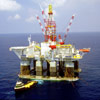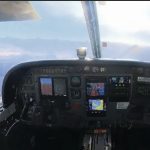The maritime sector drives the global economy, with ships transporting more than 80% of world trade. Ships and ports have come to rely on global navigation satellite systems (GNSS) for a huge array of applications relating to position, velocity and precise universal and local time.
The maritime sector drives the global economy, with ships transporting more than 80% of world trade. Ships and ports have come to rely on global navigation satellite systems (GNSS) for a huge array of applications relating to position, velocity and precise universal and local time.
It is perhaps not surprising that the fallout from GNSS failure in the maritime sector over a five day-period could cost GBP£1.1billion in lost gross value added (GVA) in the United Kingdom alone (or about 1.4 billion USD) – according to a recent study by London Economics, commissioned by Innovate UK, the UK Space Agency and the Royal Institute of Navigation. [For more on this study, see Brussels View in the July/August 2017 issue of Inside GNSS.]
The threat of GNSS disruption to ships themselves is a real one. GPS interference in the Black Sea was reported earlier this year, affecting as many as 20 ships. And the United States Coast Guard warned that a sudden loss of GPS signal had occurred on multiple outbound vessels from a non-US port in 2015. Loss of GPS input to the ship’s surface search radar, gyro units and Electronic Chart Display and Information System (ECDIS), resulted in a lack of GPS data for position fixing, radar over ground speed inputs, gyro speed input and loss of collision avoidance capabilities on the ECDIS radar display.
However, ships do not rely on just GNSS alone for position fixing. A shipmaster can also deploy radar, or cross bearings using compass; terrestrial radio navigation; even sextants. This allows ships to mitigate the impact of GPS disruption.
Regulations in the International Convention for the Safety of Life at Sea (SOLAS) require merchant ships to carry a receiver for a GNSS or a terrestrial radionavigation system, or other means, suitable for use at all times throughout the intended voyage to establish and update the ship’s position by automatic means. But they must also carry a compass, a device to take bearings, and backup arrangements for ECDIS.
The organization which oversees SOLAS and has the remit for adopting carriage requirements, operational requirements and performance standards for world shipping is the International Maritime Organization (IMO). IMO (originally known as the Intergovernmental Maritime Consultative Organization, or IMCO) is the United Nations specialized agency with responsibility for developing the regulations for ship safety and maritime security, and the prevention of pollution from ships.
IMO does not operate GNSS systems, but has an important role in accepting and recognizing worldwide radionavigation systems which can be used by international shipping.
When IMO began its work as the international regulatory body for shipping in 1959, one of its first tasks was to adopt a revised SOLAS treaty, to update the 1948 SOLAS treaty. (The very first SOLAS treaty was adopted in 1914, in the wake of the Titanic disaster, while another version was adopted in 1929.)
When the 1960 SOLAS was adopted by IMO, terrestrial radio navigation systems – including Decca Navigator and Loran A – were already in operation. In these systems, a ship’s radio receiver would measure transmissions from groups of radio transmitters sending signals simultaneously or in a controlled sequence. By measuring the phase difference between one pair of transmissions a line of position can be established. A second measurement, from another pair of stations, gives a second line and the intersection of the two lines gives the ship’s position.
In its chapter V on Safety of Navigation, SOLAS 1960 included a requirement for ships over 1,600 gross tonnage on international voyages to be fitted with radio direction-finding apparatus – a requirement dating back to the 1948 SOLAS Convention. The apparatus was required to comply with system requirements set out in SOLAS chapter IV on Radiotelegraphy and Radiotelephony (SOLAS Chapter IV is now called Radiocommunications).
By the late 1960s and early 1970s, Loran C and Differential Omega radio navigation systems were also becoming operational in major areas of the world’s oceans and they were combined with early computer technology to provide electronic printouts of the ship’s position. The then-Soviet Union’s Chayka system also became operational.
During this time, IMO Member States increasingly recognized the importance of using navigation systems in maritime safety and preventing marine pollution, for example as an aid to avoiding hazards. In 1968, IMO recommended that ships carrying oil or other noxious or hazardous cargoes in bulk should carry “an efficient electronic position-fixing device” (Assembly resolution A.156(ES.IV) Recommendation on the Carriage of Electronic Position-Fixing Equipment).
IMO’s Maritime Safety Committee was also noticing the potential for accurate position finding which satellites could provide. As with other developments in technology with shipping applications, IMO’s concern was to ensure that the user would benefit from the new technology and that such new systems would at least meet agreed performance standards.
A recommendation on accuracy standards for navigation, adopted by the IMO Assembly in 1983 (resolution A.529(13)), provided “guidance to Administrations on the standards of navigation accuracy for assessing position-fixing systems, in particular radionavigation systems, including satellite systems”. Outside harbour entrances and approaches, the order of accuracy was set at “4% of distance from danger with a maximum of 4 nautical miles”.
This was a fairly moderate requirement compared to today’s systems.
The Maritime Safety Committee had, in the meantime, begun to consider whether ships should be required – on a mandatory basis – to carry means of receiving transmissions from a suitable radio navigation system throughout their intended voyage.
A study was initiated to look at the operational requirements (including the need for reliability and low user cost) and how such systems could be recognized or accepted by IMO.
The Report on the study of a World-Wide Radionavigation System was adopted by the IMO Assembly in 1989 (resolution A.666(16)). It gave a detailed summary of the different terrestrial-based radio navigation systems then in operation (Differential Omega, Loran-C, Chayka), and also the satellite systems in development. These were the Global Positioning System (GPS) (United States) and GLONASS (Global Navigation Satellite System) (then Soviet Union – now under the Russian Federation). It was agreed that IMO would develop performance standards for GPS and GLONASS receivers.
The study concluded that it was not feasible for IMO to fund a worldwide radio navigation system. However, IMO’s role would be to review radionavigation systems against set criteria, before they could be accepted. A radionavigation system adopted by IMO should be reliable, of low user cost, meet general navigation needs, provide accuracy not less than the standards adopted in 1983, and have 99.9% availability.
The study also recommended that changes to carriage requirements should not be considered until world-wide coverage had been achieved by a radionavigation satellite system.
In 1995, an updated study was adopted as the IMO policy for the recognition and acceptance of suitable radionavigation systems intended for international use in the world-wide radio navigation system (resolution A.815(19)). This study additionally recognized the need for provision of position information to support the Global Maritime Distress and Safety System (GMDSS), by locating vessels in distress. The needs of high speed craft, such as fast ferries, were recognized and the study noted that ships operating at speeds above 30 knots may need more stringent accuracy requirements.
Performance standards for shipborne GPS receiver equipment were also adopted in 1995, and for GLONASS receivers in 1996. GPS became fully operational in 1995 and GLONASS in 1996. Both systems were recognized by IMO as components of the world-wide radionavigation system in 1996.
Meeting Maritime User Needs
IMO Member States acknowledged that there was a need to look ahead, to ensure that any future GNSS would meet maritime user needs. “Maritime Requirements for a Future Global Navigation Satellite System (GNSS)” were developed and adopted by the IMO Assembly in 1997 (resolution A.860(20)). This emphasized the need for IMO to play a continued role in monitoring the developments and ensuring that any future GNSS meets IMO requirements, including those for navigational accuracy, integrity of the service, availability, reliability and coverage.
In 2000, with both GPS and GLONASS systems now fully functional and providing the required degree of reliability, IMO moved forward with adopting mandatory carriage requirements for GNSS.
A revised SOLAS chapter V (Safety of Navigation), which entered into force in 2002, requires ships to carry a GNSS or terrestrial radionavigation receiver, to establish and update the ship’s position by automatic means, for use at all times throughout the voyage.
IMO also adopted MSC resolutions on updated performance standards for Shipborne Global Positioning System (GPS) Receiver Equipment (MSC.112(73)), for GLONASS Receiver Equipment (MSC.113(73)), for Shipborne DGPS and DGLONASS Maritime Radio Beacon Receiver Equipment (MSC.114(73)) and for shipborne combined GPS/GLONASS receiver equipment (MSC.115(73)).
Reflecting the increased positional accuracy provided by GPS and GLONASS, an updated resolution giving the IMO policy for the recognition and acceptance of suitable radio navigation systems intended for international use was adopted in 2003 by the IMO Assembly (resolution A.953(23)).
This resolution made the accuracy standards required more stringent (revoking those agreed in 1983): in harbour entrances, harbour approaches and coastal waters, positional information error should not be greater than 10 meters with a probability of 95%. In ocean waters, the system should provide positional information with an error not greater than 100 meters with a probability of 95%.
In 2011, IMO further updated the IMO policy for recognizing and accepting suitable radionavigation systems intended for international use (resolution A.1046(27)), inviting Governments to keep IMO informed of the operational development of any suitable radionavigation systems which might be considered for use by ships worldwide.
The resolution also specifically requested the Maritime Safety Committee to recognize systems conforming to IMO requirements. Such recognition would mean IMO recognizes that the system is capable of providing adequate position information within its coverage area and that the carriage of receiving equipment for use with the system satisfies the relevant requirements of the SOLAS Convention.
New GNSS Providers Recognized
The BeiDou Navigation Satellite System (BDS), proposed by the People’s Republic of China, was developed in the 2000s and IMO was requested to develop performance standards for BDS receivers. The performance standards were adopted in 2014 (resolution MSC.379(93)).
BDS was recognized as a component of the world-wide radio navigation system in 2014. Full operational capability for BeiDou is anticipated to be reached by 2020. The IMO recognition (SN.1/Circ.329) notes that the static and dynamic accuracy of the system is 100 meters (95%) and it is therefore not suitable for navigation in harbour entrances and approaches, and other waters in which freedom to maneuver is limited.
The European Galileo Global Navigation Satellite System was developed and presented to IMO as a future component of the GNSS in the early 2000s. Performance standards for Galileo shipborne receivers were adopted by IMO in 2006 (resolution MSC.233(82)). The MSC recognized Galileo in 2016 (SN.1/Circ.334), noting that, in future, the static and dynamic accuracy of the Galileo system is expected to be better than 10 meters with a probability of 95%, with integrity provided by Receiver Autonomous Integrity Monitoring (RAIM) techniques. Once full operational capability is met, it will be suitable for navigation in harbour entrances, harbour approaches and coastal waters. Full operational capability for Galileo is also anticipated to be reached by 2020.
A further system, the Indian Regional Navigation Satellite System (IRNSS) — now also known in India as NaVIC (Navigation Indian Constellation) — is now being considered by IMO. Performance standards for IRNSS receiver equipment will be developed by 2019, and its possible recognition as part of the world-wide radio navigation system will be assessed.
Multi-System Shipborne Radio Navigation Receiver Equipment
Meanwhile, in June 2015, the Maritime Safety Committee adopted performance standards for multi-system shipborne radionavigation receiver equipment to ensure that ships are provided with resilient position-fixing equipment suitable for use with available radionavigation systems throughout their voyage (resolution MSC.401(95), updated by MSC.432(98)).
Such equipment can allow the combined use of current and future radionavigation as well as augmentation systems for the provision of position, velocity and time data within the maritime navigation system.
The World-Wide RadioNavigation System for the Future
As technology continues to develop, the world-wide radionavigation system can also be seen in the context of the wider IMO strategy for e-navigation, approved in 2008, which is intended to meet present and future user needs through harmonization of marine navigation systems and supporting shore services.
A key element in the e-navigation strategy relates to position fixing systems, which will need to meet user needs in terms of accuracy, integrity, reliability and system redundancy in accordance with the level of risk and volume of traffic.
A detailed e-navigation Strategy Implementation Plan (SIP), approved in 2014, sets out a framework and a road map of tasks that would need to be implemented or conducted in the future to give effect to five prioritized e-navigation solutions, one of which is the improved reliability, resilience and integrity of bridge equipment and navigation information, and another being the integration and presentation of available information in graphical displays received via communication equipment.
IMO will continue to oversee the world-wide radionavigation system and to have a role in recognizing systems that may be developed in the future. IMO also has a role to ensure the reliability, integrity and resilience of such systems.
The development of satellite-based position systems — GNSS — has enabled a leap forward in the accuracy standards required of such systems and has no doubt contributed to improved safety, efficiency and environmental protection at sea.
This has implications for both carriage requirements for navigational equipment as well as for the human element, in terms of training requirements.
IMO will continue to provide the forum for careful consideration of any requirements, in order to maintain carriage requirements recognizing the significant value and use of GNSS, but also to ensure that alternative systems continue to be mandated, for more resiliency and redundancy.
IMO
The International Maritime Organization – is the United Nations specialized agency with responsibility for the safety and security of shipping and the prevention of marine pollution by ships.





